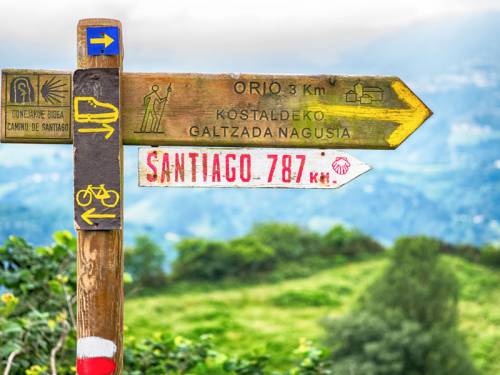An ancient discipline revives
July 12, 2022
 Among the ancient disciplines being taken on by contemporary people, the pilgrimage may be the most common. Prior to Covid, nearly a million people around the world have walked long distances on pilgrimage. Even during this current era, thousands have found a way to make the journey of a lifetime. In his book “The Pilgrim Journey: A History of Pilgrimage in the Western World,” James Harpur writes, “At the heart of pilgrimage is a spiritual impulse that has existed from time immemorial.”
Among the ancient disciplines being taken on by contemporary people, the pilgrimage may be the most common. Prior to Covid, nearly a million people around the world have walked long distances on pilgrimage. Even during this current era, thousands have found a way to make the journey of a lifetime. In his book “The Pilgrim Journey: A History of Pilgrimage in the Western World,” James Harpur writes, “At the heart of pilgrimage is a spiritual impulse that has existed from time immemorial.”
The reasons for this pilgrimage revival vary. Some walk to discern their vocation, to start over after some trauma, to fulfill a promise, to discover God and to begin a new chapter in life.
A friend and colleague, the Rev. Kenneth Kovacs of Catonsville Presbyterian Church in Baltimore, walked the Camino de Santiago in Santiago, Spain, in 2016. He was 52 and, with 30 years of pastoral experience, he wanted to reflect on his vocation.
“Where was God calling me? What was being asked of me?” recalled Kovacs. “I wanted to listen to my heart, to my feelings and my dreams. The Camino provided a way forward that I continue to walk.”
Mixed in with all these motives is the sheer adventure of the journey. Not everyone, though, experiences a sense of life transformation, especially those who undertake the journey less as a spiritual pilgrimage and more as another exotic travel adventure.
Yet, for those who walk with intention, who have prepared mentally, physically and spiritually, a pilgrimage can forever mark one’s life. That is certainly true for me.
In 2015, I walked 500 miles to Santiago on the Camino de Santiago pilgrimage route.
There are many paths to the shrine of the apostle St. James the Great in the Cathedral of Santiago de Compostela in Galicia in northwestern Spain, where tradition has it the remains of the saint are buried. Pilgrims follow these routes as a form of spiritual practice, an opportunity for spiritual growth or even penance.
In the 9th century, when King Alfonso the Chaste was king of the Asturias region of Spain and Oviedo was the capital, he made a pilgrimage over the mountains to Santiago to confirm the authenticity of the bones of St. James recently found there, thus establishing the oldest known pilgrimage route in the world. This route is known as the Camino Primitivo, or “The Original Way.”
Today, when people hear about the Camino de Santiago, they think of the pilgrimage from St. Jean Pied de Port in France over the Pyrenees mountains to Santiago. This route was established later in the 11th century by the kings of Leon and Burgos, after King Alfonso fell from power and the capital was moved to Leon. For economic reasons, they wanted pilgrims to travel through their territories on the way to Santiago.
Thousands walked this way. But like many medieval practices, it fell away. In the 1970s, a priest decided to renew the 11th-century Camino de Santiago and enlisted helpers. It is now the most popular pilgrimage in the world. Pope Francis described it as a path of human solidarity as well as religious awakening. That solidarity can be seen at times by the pilgrims carrying a shell on their backpacks as a Christian symbol of baptism linking them to the past. Other contemporary pilgrims walk with a single staff linking them to history. I walked with my hiking poles and carried my shell on my pack.
As part of my intentional practice, I committed each day to reflection on one of the fruits of the Spirit, and later to the qualities of love. Each morning before sunrise, I put all my belongings in my pack, stepped out the door and began walking in faith, not knowing where I would eat or sleep and who I would meet.
I met pilgrims from across the world, some of whom remain close friends. For me, it was a concentrated experience of the church in the deepest way possible: communal sharing in one another’s burdens, sharing our life stories, carrying burdens, breaking bread and knowing the conviviality of the Spirit that transcends all parochial bounds. The entire journey was humbling, joyous and heart-opening.
The Rev. Roy Howard, living in North Potomac, Maryland, served for 18 years as pastor of Saint Mark Presbyterian Church in Bethesda, Maryland, and is a certified coach with the International Coaching Federation and dean of the Academy of Artful Leadership
Let us join in prayer for:
PC(USA) Agencies’ Staff
Ruth Adams, Director, Assistance Program, Church Engagement, Board of Pensions
Simone Adams, Coordinator, Budget & Mission Effectiveness, Theology, Formation & Evangelism, Presbyterian Mission Agency
Let us pray
Lord God, thank you for the growth of your church and the millions of lives touched with your love. Be with those who holistically proclaim the gospel through witness, service and advocacy. In Christ’s name we pray. Amen.

No comments:
Post a Comment